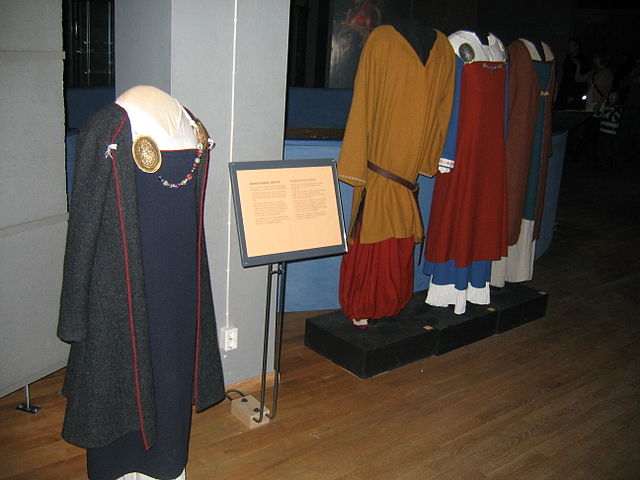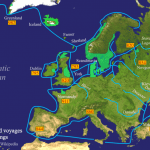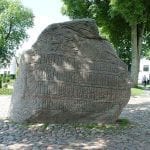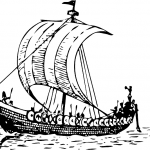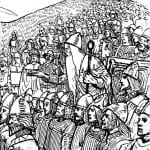Very little fabric survives 1,000 years, but surprisingly, some has. What we know of Viking clothing comes from archeological finds, although we also glean some clothing descriptions from the sagas.
Vikings all wore the same basic clothing styles: for men, a thick shirt known as a tunic was worn over trousers. Women wore one long dress, floor or ankle length, with an apron-style dress over it. The apron dress hung from straps over the shoulders fastened by two brooches in the front. Underneath these woolen garments, both men and women wore linen undershirts or shifts, which they might have slept in. Children wore the same styles as the adults, but cut to their much smaller sizes.
Vikings’ over garments were made from wool, a warm, durable fabric that kept out cold and wind. Scandinavians needed the warmth, and clothes were so time-consuming to make that one set of clothing had to last. Viking sheep provided the wool for clothes and Viking farms grew the flax, from which linen is made. Viking women spent most of their time spinning and carding wool, weaving fabric and making her family’s clothes.
Viking warriors, farmers and artisans required tunics that fit well. A Viking’s krytill or over tunic was cut from a complex pattern and the many pieces were then stitched together to create a fitted garment where the arms and shoulders could move easily and freely. The tunic came down into a broad skirt that reached to the thighs or knees. A keyhole neckline made it easy to fit the kyrtill over the head. Most Viking men wore a simple braid trim on the neckline and around the cuffs of the sleeves. Women wove the braid for trim from brightly colored yarns.
A Viking’s trousers could be worn tight or loose and were held up by a belt or by a string passed through a loop. Made from wool, trousers were also warm and could be tucked into boots or left loose. Shoes for both sexes were simple, but crafted from durable goat skin.
A woman’s overdress also had a keyhole neckline with long sleeves and fell to the ankle or floor. Over this, a Viking wife wore an apron-dress with panels of fabric in front and back, held on the shoulders by straps which were fastened by two brooches, known as turtle brooches because of their shape. These brooches could be made of bone, ivory, bronze, silver or even gold for wealthier Viking women. A string of colorful glass, amber and jet beads decorated the front of the apron dress, hanging between the two brooches.
Vikings wore long, warm, wool cloaks over their clothes for warmth outside. Hats were made of wool, leather or fur. Woolen socks kept the feet warm under the shoes or boots, and leather belts pulled the outfits together. Pouches, knives and other tools hung off the belt so were close to hand.
Cloth was dyed bright colors using vegetable-based dyes, creating a variety of colors from light browns to russets to red, yellow, gold and blue. Wealthier Vikings could afford silk, but this imported fabric was rare in Viking culture.
This article is part of our larger selection of posts about Vikings history. To learn more, click here for our comprehensive guide to Vikings history
Cite This Article
"Viking Clothing: Warm and Durable" History on the Net© 2000-2024, Salem Media.
April 20, 2024 <https://www.historyonthenet.com/viking-clothing-warm-and-durable>
More Citation Information.



